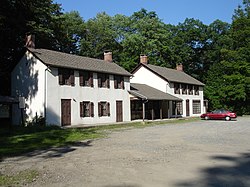
Ringwood is a borough in Passaic County, in the U.S. state of New Jersey. As of the 2020 United States census, the borough's population was 11,735, a decrease of 493 (−4.0%) from the 2010 census count of 12,228, which in turn reflected a decrease of 168 (−1.4%) from the 12,396 counted in the 2000 census.
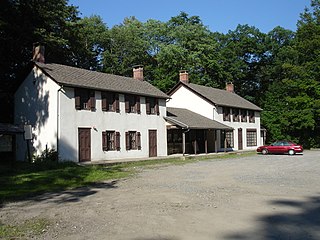
West Milford is a township in Passaic County, in the U.S. state of New Jersey. As of the 2020 United States census, the township's population was 24,862, a decrease of 988 (−3.8%) from the 2010 census count of 25,850, which in turn reflected a decline of 560 (−2.1%) from the 26,410 counted in the 2000 census. It is the largest in the county by total area, covering 80.32 square miles (208.0 km2) and more than 40% of the county.
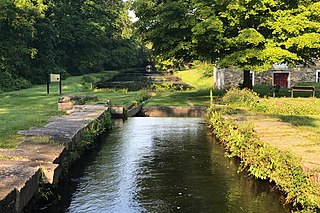
The Morris Canal (1829–1924) was a 107-mile (172 km) common carrier anthracite coal canal across northern New Jersey that connected the two industrial canals in Easton, Pennsylvania across the Delaware River from its western terminus at Phillipsburg, New Jersey to New York Harbor and New York City through its eastern terminals in Newark and on the Hudson River in Jersey City. The canal was sometimes called the Morris and Essex Canal, in error, due to confusion with the nearby and unrelated Morris and Essex Railroad.

Saugus Iron Works National Historic Site is a National Historic Site about 10 miles northeast of Downtown Boston in Saugus, Massachusetts. It is the site of the first integrated ironworks in North America, founded by John Winthrop the Younger and in operation between 1646 and approximately 1670. It includes the reconstructed blast furnace, forge, rolling mill, shear, slitter and a quarter-ton trip hammer.
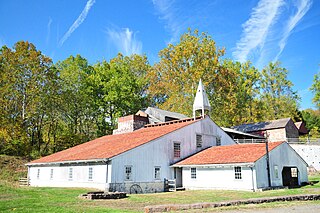
Hopewell Furnace National Historic Site in southeastern Berks County, near Elverson, Pennsylvania, is an example of an American 19th century rural iron plantation, whose operations were based around a charcoal-fired cold-blast iron blast furnace. The significant restored structures include the furnace group (blast furnace, water wheel, blast machinery, cast house and charcoal house), as well as the ironmaster's house, a company store, the blacksmith's shop, a barn and several worker's houses.

The Wanaque River is a tributary of the Pequannock River in Passaic County in northern New Jersey in the United States.

Ringwood Manor, located in Passaic County, New Jersey, was the site of an ironworks and home to a number of well-known ironmasters from the 1740s to the late 19th century. The current manor house was not built until 1807.

Greenwood Lake is an interstate lake approximately seven miles (11 km) long, straddling the border of New York and New Jersey. It is located in the Town of Warwick and the Village of Greenwood Lake, New York and West Milford, New Jersey. It is the source of the Wanaque River.

The Tannehill Ironworks is the central feature of Tannehill Ironworks Historical State Park near the unincorporated town of McCalla in Tuscaloosa County, Alabama. Listed on the National Register of Historic Places as Tannehill Furnace, it was a major supplier of iron for Confederate ordnance. Remains of the old furnaces are located 12 miles (19 km) south of Bessemer off Interstate 59/Interstate 20 near the southern end of the Appalachian Mountains. The 2,063-acre (835 ha) park includes: the John Wesley Hall Grist Mill; the May Plantation Cotton Gin House; and the Iron & Steel Museum of Alabama.

Tahawus was a village in the Town of Newcomb, Essex County, New York, United States. It is now a ghost town situated in the Adirondack Park. Tahawus is located in Essex County within the unpopulated northern area designated to the town of Newcomb. Tahawus was the site of major mining and iron smelting operations in the 19th century. Although standing as recently as 2005, the last mining facilities have since been demolished and removed.
Hewitt is an unincorporated community and census-designated place (CDP) located within West Milford Township in Passaic County, in the U.S. state of New Jersey. The area is served as United States Postal Service ZIP Code 07421. It is named for Abram Hewitt.
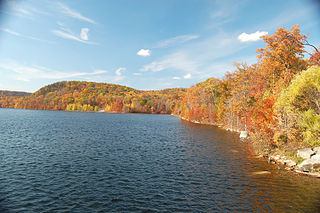
The Monksville Reservoir is an artificial lake created in 1987 by damming on the Wanaque River in Ringwood, New Jersey. It is named after the former community of Monksville, which was relocated and flooded upon its completion.

The Richmond Furnace Historical and Archeological District is a historic industrial area located on State, Cone Hill, and Furnace Roads in Richmond, Massachusetts. The industrial history of the site dates to 1763 when the first grist and sawmills were built. In 1829, the first stone furnace was constructed for the production of iron from abundant hematite ore found nearby. It was rebuilt in 1863, and overhauled in 1905 to increase capacity. The area saw industrial iron production until 1923. The historic district also includes several other houses and buildings related to the iron works. It was added to the National Register of Historic Places in 1999.

The Brierfield Furnace, also known as the Bibb Naval Furnace and Brierfield Ironworks, is a historic district in Brierfield, Alabama, encompassed by Brierfield Ironworks Historical State Park. The district covers 486 acres (197 ha) and includes one building and nine sites. It was listed on the National Register of Historic Places on November 20, 1974.

The Clinton Furnace, also known as the Clinton Ironworks, is located along Clinton Road at the base of the Clinton Reservoir by the Clinton Brook in the township of West Milford in Passaic County, New Jersey, United States. The furnace was built in 1826 and was added to the National Register of Historic Places on June 18, 1976, for its significance in industry. The furnace is the last surviving structure of the iron community once known as Clinton.

The Beckley Furnace Industrial Monument is a state-owned historic site preserving a 19th-century iron-making blast furnace on the north bank of the Blackberry River in the town of North Canaan, Connecticut. The site became a 12-acre (4.9 ha) state park in 1946; it was added to the National Register of Historic Places in 1978.

The Southfield Furnace Ruin in Southfields, New York, was a longtime smelting site for iron ore mined from nearby veins in what is now Sterling Forest State Park. It is located on the north side of Orange County Route 19, 0.7 miles northwest of the junction with New York State Route 17.
Tranquility Ridge Park is a 2,062 acre Watershed Protection Area that spans the border of Ringwood and West Milford, New Jersey, United States, and is directly south of the New Jersey-New York State Line. Tranquility Ridge Park is directly adjacent to Sterling Forest State Park in NY, and Long Pond Ironworks State Park in NJ. The area was once part of Long Pond Ironworks, which was developed as an ironworks "plantation" by Peter Hasenclever in 1766, and produced iron for American forces during the American Revolutionary War, the War of 1812, and the American Civil War.
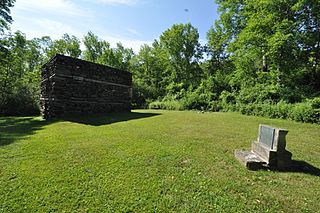
The Mount Riga Ironworks was one of the most successful manufacturers of iron in the late colonial and post-Revolutionary period of United States history. Located in the far northwestern Connecticut town of Salisbury, it produced high quality iron for use in military and domestic applications, and supported a community of 1,200 people. It declined in the mid-19th century, and was closed in 1847. Surviving elements include an early 19th-century cold blast furnace and other foundational and archaeological remains. Its site, now part of a large private holding owned by the Mount Riga Corporation, was listed on the National Register of Historic Places in 1994.

The Lithgow Blast Furnace is a heritage-listed former blast furnace and now park and visitor attraction at Inch Street, Lithgow, City of Lithgow, New South Wales, Australia. It was built from 1906 to 1907 by William Sandford Limited. It is also known as Eskbank Ironworks Blast Furnace site; Industrial Archaeological Site. The property is owned by Lithgow City Council. It was added to the New South Wales State Heritage Register on 2 April 1999.
